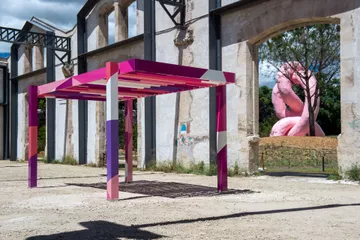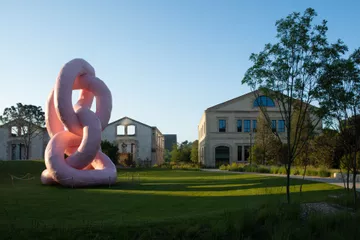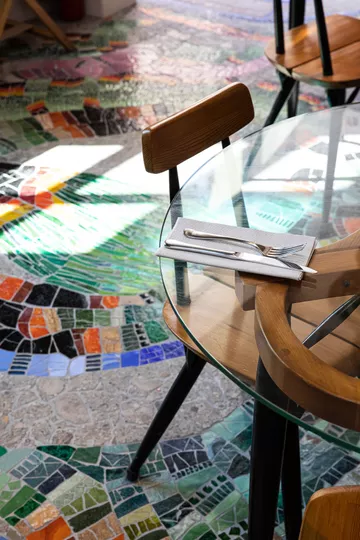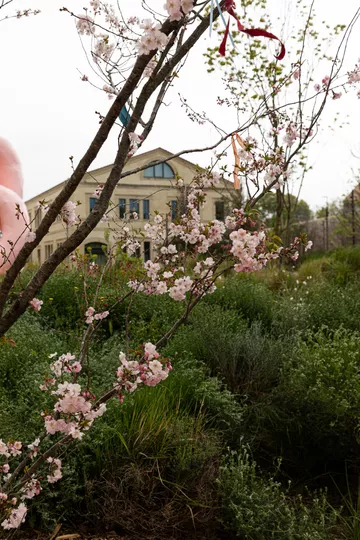
Landscaped park: artists interventions
Koo Jeong-A, Liam Gillick, Franz West, Carsten Höller, Kerstin Brätsch, Dominique Gonzalez-Foerster
Parc des Ateliers
Starting from
The landscaped park and outdoor installations are freely accessible and do not require an entry ticket.
OooOoO
Koo Jeong-A
The Tower terrace
Korean artist Koo Jeong-A has created a glow in the dark full scale skatepark, which is installed on the public terrace adjacent to The Tower. The skating bowls are painted with fluorescent paint that illuminates the entire structure at night, creating different light conditions. The work is based on the idea of play and performativity and essential elements of contemporary culture, and the skatepark is an evidence of what it means to play with a specific intention and very real skills. Skating is also a choreography in space, with its own speed and movements. Skaters’ bodies achieve remarkable positions of balance, endeavour and endurance and are offering radical new perspectives in the experience of architectural space as we know it.
Orientation Platforms
Liam Gillick
Through the landscaped park
Liam Gillick’s Orientation Platforms are sculptures made of metal that have a dual reality. They are places to hang out at, when there is nothing else around to do, but also a place for contemplation and discussion, specifically around the sculpture itself.
They are designed to be entwined to architecture and space but feature an inherent friction between presentation and purpose, utility and aesthetics.
To learn more, have a look at the interview with Liam Gillick.
Krauses Gekröse
Franz West
Landscaped park
It is a 13-metre-high sculpture in pink, installed in the garden, between The Tower and the building of Les Forges. The sculpture has never been installed before in height, it has only been installed once in the artist’s studio on the floor. This is a piece seen for the first time as it was intended by West.
Seven Sliding Doors Corridor
Carsten Höller
Landscaped park
Seven Sliding Doors Corridor (Outdoor Version) consists of electronic sliding doors with mirrored surfaces on both sides, through which a viewer can walk in an apparently endless passage. The doors are installed inside a reflective corridor spanning the pond in the park. Inside that space, the doors are positioned at evenly-spaced intervals and are connected to motion sensors that cause them to slide open when someone approaches and close shut when the person moves away. As a result, the movements of viewers alternately break and bind the visual limits of the space, which can be entered from either end of the corridor, increasing the likelihood of unexpected encounters as the doors open and close.
MEMORY
Kerstin Brätsch
Café du Parc
An environment consisting of Stone Mimicry, wall embedded Fossil Psychics, wall color scheme, antique glass, and selected artist designed furniture.
The mosaic floor of the Café du Parc is based on paintings by Kerstin Brätsch. Envisaged by the artist as monumental paitings looking towards the sky, the mosaic represents different characters often found in Brätsch‘s oil on mylar paintings. The characters here are enlarged and oversized and translated into mosaic techniques, a unique process and use in the artist’s practice. Paths between the single characters consist of a stucco marmo creature which is turned into a mosaic. Similar motifs continue in the interior space of the Café du Parc, which unify the park and the interior in a spectacular way. The forms are visually powerful and command the views from The Tower to the park.
To learn more, have a look at the interview with Kerstin Brätsch.
kitsune-tremblement
Dominique Gonzalez-Foerster
Landscaped park
The display of the interviews in the Cherry Tree Gallery revisits Now Interviews, initially conceived by Japanese architect Kazuyo Sejima, on the occasion of the 12th Architecture Biennale in 2010. For the presentation at LUMA Arles, Sejima suggested that a tree could be planted in front of a window. This space was thus named the Cherry Tree Gallery.
As an echo or resonance to Yoko Ono’s Wish Tree, on the occasion of the overall opening of LUMA Arles on June 26, 2021, Dominique Gonzalez-Foerster tied ribbons in the colours of Post-it notes to the branches of the tree chosen by Sejima and visible through the window.
Artists biographies
Koo Jeong A
The work of Koo Jeong A incorporates intersubjective phenomena, digital features and timely imaginaries with the capacity to transform into large-scale sculpture and painting, as well as film, animation, sound and scent, to reinvent the architectural space. The artist’s site-specific reconfigurations open up narrative portals, where the various media are combined with natural elements, such as wind or gravity and the electromagnetic field. In this way, alternative realities are conjured, not only geographically, but also in an astral sense, tracing the poetry that permeates their unique universe. Koo Jeong A’s installation works trigger a regeneration and dynamism in the area in which they are situated. Projects like the Glow in the Dark Skatepark series are situated in the public arena and become part of the infrastructure of the city or the cultural destination in a wide collaboration with local citizens and governments.
Koo Jeong A’s interest in the concept of the void also plays an important role. Installed in a site without the interaction of human beings, and affected only by the changing light of day and night. To the artist, art is an act of reverence that constantly incites the surprise of discovery, extending towards an unstoppable state of dynamism.
Liam Gillick
Liam Gillick deploys multiple forms to expose the new ideological control systems that emerged at the beginning of the 1990s. Gillick’s work ranges from small books to large-scale architectural collaborations. His practice exists in a constant tension between his formally minimalistic works that reflect upon the language of renovated space, and his critical approach through writing and the use of text. This approach is brought together in a continual testing of the conventions of the exhibition as form. In addition, he has produced a number of short films since the late 2000s, which address the construction of the creative persona in the light of the enduring mutability of the contemporary artist as a cultural figure. Throughout this time, Gillick has extended his practice into experimental venues and collaborative projects with artists including Philippe Parreno, Lawrence Weiner and Louise Lawler.
Franz West
From abstract and interactive sculpture to furniture and collage, Franz West’s works possess a character that is at once lighthearted and deeply philosophical. Belonging to a generation of artists exposed to the Actionist and Performance Art of the 1960s and 70s, West instinctively rejected the idea of a passive relationship between artwork and viewer. Opposed to the existential intensity requisite to his performative forebears (such as Actionism), he produced work that was vigorous and imposing yet unbounded and buoyant.
In 1973, he began creating compact, portable, mixed media sculptures called Passstücke (Adaptives). These “ergonomically inclined” objects were actualized as artworks only when touched, held, worn, carried, or otherwise physically or cognitively engaged. Transposing the concepts engendered by these formative works, he explored sculpture increasingly through the framework of the ongoing dialogue between viewers and objects, while probing the internal aesthetic relations between sculpture and painting. Manipulating everyday materials and imagery in order to examine art’s relation to social experience, West revolutionized the interplay of concealment and exposure, action and reaction, both in and outside the gallery.
Public collections including Centre Georges Pompidou, Paris; Tate, London; Albertina, Vienna; Museum of Contemporary Art, Los Angeles; Walker Art Center, Minneapolis; Philadelphia Museum of Art; Hirshhorn Museum and Sculpture Garden, Washington, DC; and Museum of Modern Art, New York. He was awarded the Golden Lion for Lifetime Achievement at the 54th Biennale di Venezia in 2011.
Carsten Höller
Carsten Höller uses his training as a scientist in his work as an artist, concentrating particularly on the nature of human relationships. Born in Brussels in 1961, he now lives and works in Stockholm, Sweden, and Biriwa, Ghana. His major installations include Test Site, a series of giant slides for Tate Modern’s Turbine Hall (2006), Amusement Park - an installation of full-size funfair rides turning and moving at very slow speed at MASS MoCA, North Adams, USA (2006), Flying Machine (1996), a work which hoists the viewer through the air, Upside-Down Goggles, an experiment with goggles which modify vision, and the famous The Double Club (2008-2009) in London, which opened in November 2008 and closed in July 2009, that took the form of a bar, restaurant and nightclub designed to create a dialogue between Congolese and Western cultures. His Revolving Hotel Room, 2008, a rotating art installation that becomes a fully operational hotel room at night, was shown as part of theanyspacewhatever exhibition at the Guggenheim Museum in 2009. For his 2015 exhibition Decision at the Hayward Gallery, he turned the whole building into an experimental parcours with two entrances and four exits, two of them being slides.
His works have been shown internationally over the last two decades, including solo exhibitions at Fondazione Prada, Milan (2000), the ICA Boston (2003), Musée d’Art Contemporain, Marseille (2004), Kunsthaus Bregenz, Austria (2008), Museum Boijmans Van Beuningen, Rotterdam (2010), Hamburger Bahnhof, Museum für Gegenwart, Berlin (2011), New Museum, New York (2011) Thyssen-Bornemisza Art Contemporary (TBA21), Vienna (2014), Pirelli HangarBicocca, Milan (2016), Henie Onstad Kunstsenter, Høvikodden, Norway (2017), The Florence Experiment at the Palazzo Strozzi, Florence (2018), Sunday at Museo Tamayo, Mexico City (2019) and most recently the exhibitions Behaviour at Kunsten Museum of Modern Art, Aalborg (2019) and Reproduction at Copenhagen Contemporary, Copenhagen (2019).
Kerstin Brätsch
Kerstin Brätsch (b. Hamburg, Germany) is a painter who currently works in New York. Through her materially varied practice, Brätsch seeks to expand the definition of painting, continually challenging its delimitations. To destabilize the traditional notion of painting and authorship, she invites artisanal practices (such as stained glass, paper marbling, Stucco marmo) and collaborative projects into the equation of the history of the medium, shifting its agency from the singular to the collective. In fact, Brätsch works both autonomously and in collaboration with other artists, as part of DAS INSTITUT (with Adele Röder, from 2007) and KAYA (with Debo Eilers, from 2010) as well as other collectives, including UNITED BROTHERS (Ei and Tomoo Arakawa). Brätsch has been the subject of several solo exhibitions, including the Serpentine Galleries, London (2016); Museum Brandhorst, Münich (2017); and Fondazione Memmo, Rome (2018), and in 2019 she completed the site specific installation Fossil Psychics for Christa for The Museum of Modern Art’s Terrace Café, New York. In 2017, she was awarded the second edition of the Edvard Munch Art Award. In 2019, Brätsch received the Villa Romana Residency in Florence, Italy with her collective KAYA and most recently she was awarded the Helen Frankenthaler award for painting from the Foundation for Contemporary Arts, New York (2020).
Dominique Gonzalez-Foerster
Dominique Gonzalez-Foerster was born in 1965 in Strasbourg, France. She studied at École des Beaux-Arts, Grenoble, L’École du Magasin, Centre National d’Art Contemporain de Grenoble and Institut des hautes études en arts plastiques, Paris. The artist lives and works in Paris. She participated in the Venice Biennale in 1990, 1993, 1999, 2003, 2009, and 2019.
Gonzalez-Foerster participated in dOCUMENTA(11) in 2002. In 2008, she created TH.2058 as part of The Unilever Series in the Turbine Hall at Tate Modern, London. The artist received the prestigious Marcel Duchamp Award in 2002. Since 1990, Dominique Gonzalez-Foerster has been exploring the different modalities of sensory and cognitive relationship between bodies and spaces, real or fictitious, up to the point of questioning the distance between organic life and work. Metabolizing literary and cinematographic, architectural and musical, scientific and pop references, Dominique Gonzalez-Foerster creates “chambres” and “interiors”, “gardens”, “attractions” and “planets”, with respect to the multiple meanings that these terms take on in the works of Virginia Woolf or Nathaniel Hawthorne, the Brontë sisters or Thomas Pynchon, Joanna Russ or Philip K. Dick. This investigation of spaces extends to a questioning of the implicit neutrality of practices and exhibition spaces. Her “mises en espace”, “anticipations” and “apparitions” seek to invade the sensory domain of the viewers in order to operate intentional changes in their memory and imagination. Haunted by history and future, Gonzalez-Foerster’s works become containers where the artist incubates a form of subjectivity that does not yet exist.




